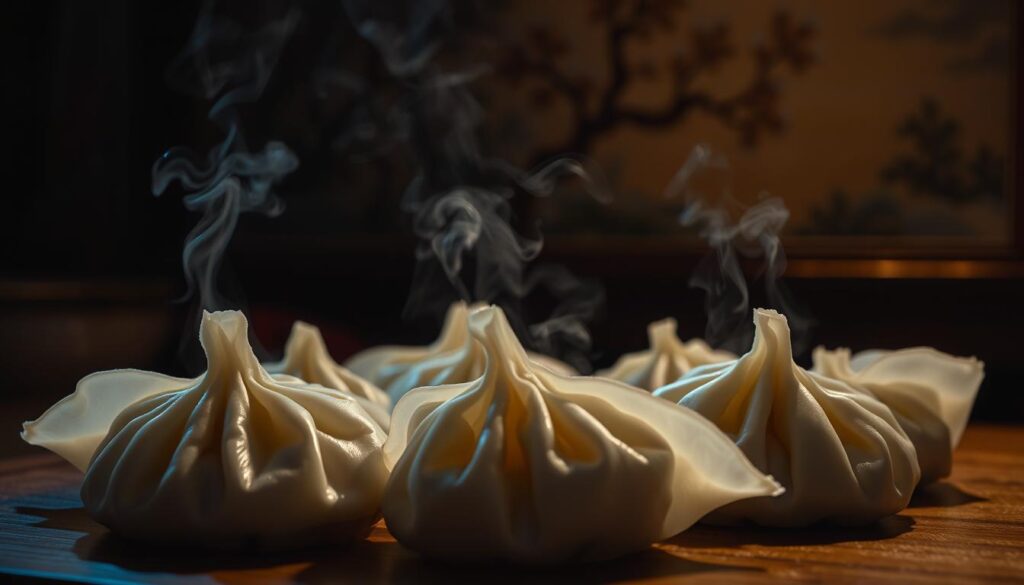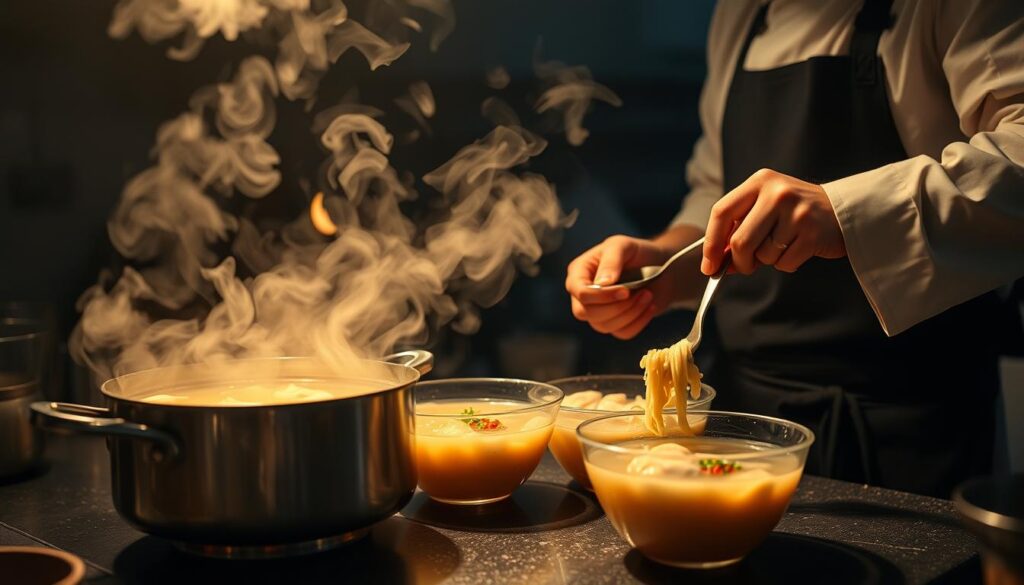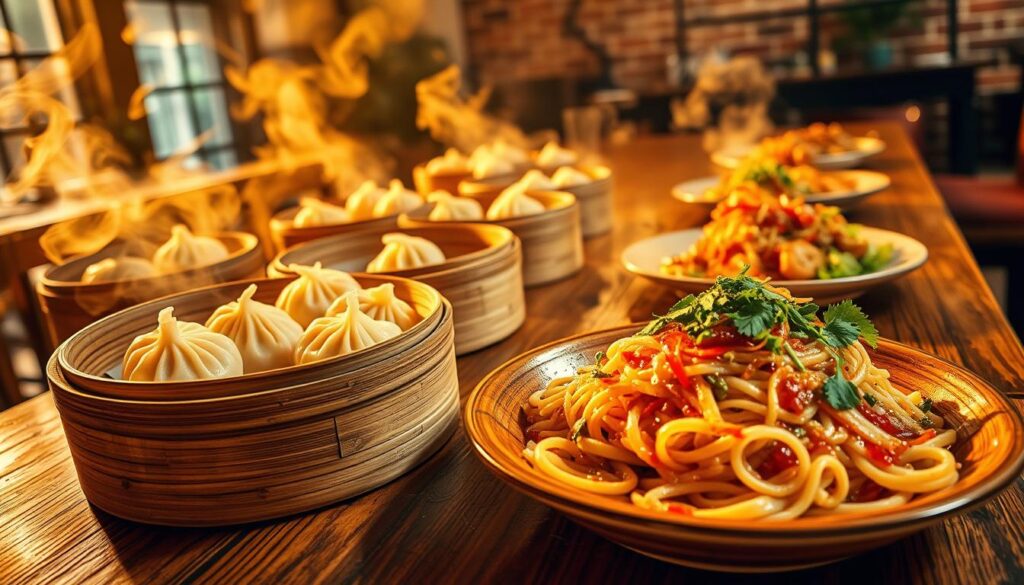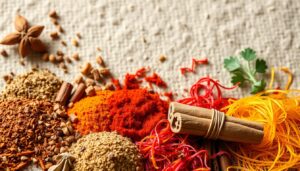Growing up, our family loved Asian food. I remember the excitement when dumpling the noodle dishes came to our table. The tender dumplings and silky noodles brought us all together, creating lasting memories.
Asian cuisine is full of amazing flavors and textures. The dumpling the noodle dish is a perfect example. It turns simple ingredients into a comforting meal that warms your heart and soul.
This guide will show you how to make a real dumpling the noodle recipe. It’s perfect for both experienced cooks and curious food lovers. You’ll learn how to make a dish that honors the rich noodle traditions of Asia.
Get ready for a tasty adventure that will make your cooking better. It will take you on a journey to the lively kitchens of Asia.
Understanding the Classic Dumpling the Noodle Combination
Dumplings are a key part of Chinese food, telling a story that spans many generations. They bring people together through a shared love of food that goes beyond just eating.

Asian dumplings come from a rich cultural background, meaning more than just a meal. They stand for family, celebrations, and cooking traditions passed down through the ages.
Origins and Cultural Significance
Dumplings have a long history in ancient China, starting as a way to keep food fresh. Each area developed its own dumpling style, using local ingredients and cooking methods.
- Northern China: Known for wheat-based wrapper dumplings
- Southern China: Preferred rice-based dumpling variations
- Coastal regions: Seafood-filled dumplings became popular
Traditional Preparation Methods
Making real dumplings takes skill and patience. Chefs use three main ways to cook them:
- Boiling: Creates soft, delicate textures
- Steaming: Preserves nutritional integrity
- Frying: Generates crispy, golden exteriors
Key Flavor Profiles
Dumplings offer a mix of flavors from their ingredients. Fillings like ground pork, shrimp, and veggies, along with spices, make for a rich taste experience.
The art of dumpling making is a testament to culinary creativity and cultural preservation.
Essential Ingredients for Perfect Dumpling Noodle Soup

To make a great dumpling noodle soup, you need the right ingredients. These ingredients add depth and flavor to your dish. Start by learning about the key parts that make a simple meal unforgettable.
For a top-notch dim sum soup, pick fresh and quality ingredients. The right wonton wrappers and proteins can make your soup amazing.
Core Ingredients List
- Chicken or vegetable stock
- Fresh wonton wrappers
- Protein options (chicken, shrimp, or tofu)
- Green onions
- Fresh mushrooms
- Pak choy
Flavor Enhancers
| Ingredient | Flavor Profile | Quantity Recommendation |
|---|---|---|
| Soy Sauce | Umami, Salty | 2-3 tablespoons |
| Sesame Oil | Nutty, Rich | 1 tablespoon |
| Ginger | Spicy, Aromatic | 1-inch piece, minced |
Pro tip: Freshness is key in making dim sum soups. Choose ingredients at their best to get the most flavor and nutrition.
The secret to an outstanding soup lies in the quality of your ingredients and the love you put into preparing them.
Preparing the Flavorful Broth Base
Making a great broth is key to any Asian dish. In Chinese cooking, the broth is the dish’s heart. It turns simple ingredients into a feast for the taste buds. Your dumpling noodle soup starts with a special liquid base that makes every bite better.

Picking the right stock is vital for deep, rich flavors found in Asian dishes. To make your broth perfect, consider these important points:
- Choose high-quality chicken or vegetable stock as your base
- Select organic, low-sodium options for better control of seasoning
- Consider homemade stock for maximum flavor intensity
Stock Selection and Enhancement
Building your broth involves layering flavors. Start with a clean, clear stock and add more depth. Traditional Chinese food techniques involve slowly simmering ingredients to extract maximum taste. Add ingredients like:
- Ginger root
- Garlic cloves
- Green onion whites
- Dried shiitake mushrooms
Seasoning and Aromatics
The secret to Asian cuisine is in its subtle seasoning. Add depth to your broth with special aromatics and seasonings. A mix of soy sauce, sesame oil, and rice wine can make your stock amazing.
Achieving the Right Consistency
Your broth should be just right – not too thin or too thick. Aim for a light, clean texture that lets the dumpling and noodle flavors stand out. Strain your broth several times for clarity and smoothness.
Pro tip: Let your broth simmer gently, allowing flavors to meld without becoming muddy or overpowering.
Mastering Homemade Dumpling Preparation
Making delicious dumplings from scratch is an art. It changes how you see food. Whether you’re making traditional gyoza or trying new potstickers, homemade dumplings taste amazing.
Begin with a filling that has protein and veggies. You can use ground pork, chicken, or plant-based options. Make sure to chop the ingredients finely so they mix well.
- Select fresh, high-quality ingredients
- Chop filling components uniformly
- Season with garlic, ginger, and green onions
- Mix ingredients thoroughly
Getting the dough right is key for great dumplings. You’ll need flour, water, and a bit of care. Roll the dough thin to make delicate wrappers that show off your filling.
“The secret to great dumplings lies in the balance between wrapper and filling” – Traditional Asian Cooking Wisdom
Folding techniques can be simple or fancy. Try different folds to find what you like best. Keeping the size the same helps with even cooking and looks good too.
- Roll dough into small circles
- Place filling in center
- Seal edges carefully
- Crimp or fold as desired
Steaming, boiling, or pan-frying each has its own flavor. Try different ways to cook to find your favorite.
Noodle Selection and Cooking Techniques
Choosing the right noodles is key to making tasty noodle dishes in Asian cuisine. The type of noodle you pick can change the whole meal. It’s important to know the differences between various noodles.
Exploring noodles means learning about their special traits and how to cook them. Not all noodles are the same. Each type adds its own texture and taste to your dish.
Types of Suitable Noodles
- Egg noodles: Soft, rich flavor perfect for hearty broths
- Rice noodles: Light and delicate, ideal for lighter dumpling dishes
- Wheat noodles: Robust and chewy, great for substantial meals
- Instant ramen noodles: Quick option (without seasoning packets)
Proper Cooking Times
| Noodle Type | Cooking Time | Recommended Technique |
|---|---|---|
| Egg Noodles | 3-4 minutes | Boil in salted water |
| Rice Noodles | 2-3 minutes | Quick hot water soak |
| Wheat Noodles | 4-5 minutes | Rolling boil |
Texture Management
Getting the right noodle texture is all about paying attention. Al dente is what you’re aiming for. Noodles should be tender but still have a bit of chew. Don’t overcook them, or they’ll become mushy and unappealing.
Pro tip: Always rinse noodles in cold water after cooking. This stops the cooking and prevents clumping. It helps your noodle dishes keep their perfect texture and look.
Combining Vegetables and Aromatics
Vegetables and aromatics are key in making your chinese food dish stand out. The right mix can turn a simple meal into a memorable one.
Choosing the right vegetables is crucial for delicious asian dumplings. They should match the flavors of your noodles and broth. Here are some top picks:
- Pak choy: A tender green vegetable with a mild, slightly sweet flavor
- Shiitake mushrooms: Adds rich, earthy undertones
- Green onions: Provides a fresh, sharp accent
- Baby spinach: Introduces a subtle, nutritious element
Aromatics are also vital in chinese food. They add depth and complexity to your dumpling noodle soup.
| Aromatic | Flavor Profile | Best Used In |
|---|---|---|
| Ginger | Spicy, warming | Broth base and dumpling filling |
| Garlic | Pungent, robust | Sautéed vegetables and marinades |
| Scallions | Mild, oniony | Garnish and fresh topping |
When cooking your vegetables, slice them thinly. Add them at the right time. Timing is everything for a balanced dish.
“In chinese food, vegetables are not just ingredients, they are storytellers of flavor and tradition.” – Chef Ming Chen
Assembly and Serving Tips
Making the perfect dim sum noodle dish is more than cooking. It’s about layering, garnishing, and keeping the right temperature. These steps make your dish a true delight.
Layering Components with Precision
The secret to a great noodle dish is how you place ingredients. Here’s how to do it right:
- Start with cooked noodles at the bottom of your bowl
- Arrange steamed dumplings on top of the noodles
- Pour hot broth around the dumplings
Garnishing for Visual and Flavor Enhancement
Turn your dim sum into a feast for the eyes with these garnishes:
- Sprinkle chopped green onions
- Add a drizzle of chili oil for spice
- Top with fresh cilantro leaves
- Include thin slices of fresh ginger
Temperature Control Essentials
Keeping the right temperature is key in Asian cooking. Serve your dish right away for the best taste and texture.
| Component | Ideal Temperature | Serving Recommendation |
|---|---|---|
| Noodles | Hot (around 180°F) | Serve immediately after cooking |
| Dumplings | Steaming hot (around 165°F) | Place on top of noodles just before serving |
| Broth | Simmering (190-200°F) | Pour over noodles and dumplings right before eating |
“In dim sum, presentation is as important as flavor” – Traditional Asian Culinary Wisdom
Follow these tips to make a dim sum noodle dish that wows everyone. It will impress both your eyes and taste buds.
Variations and Creative Adaptations
Exploring new ways to make dumplings and noodle dishes is thrilling. Your recipe can become many tasty versions that please different tastes and diets.
For those who love meat, try unique fillings. Here are some ideas:
- Ground lamb with mint and cumin
- Shredded duck with hoisin sauce
- Spicy plant-based protein crumbles for vegetarian options
- Seafood-based fillings like crab or shrimp
Vegetable fans can make noodle dishes even better. Roasted seasonal vegetables bring flavor and health to your dumplings. Try using roasted butternut squash, grilled eggplant, or caramelized fennel for a twist.
Spice levels can also be changed to suit your taste. You can make them mild or very spicy. Use Korean gochujang, Mexican chipotle, or Indian masala to spice up your noodles.
Even with dietary limits, you can still have fun in the kitchen. Use gluten-free noodles, plant-based wrappers, and other proteins to make everyone happy.
Conclusion
Your journey through Asian dumplings and noodle dishes is more than just cooking. It’s about exploring flavors, techniques, and cultural traditions. These elements turn simple ingredients into amazing meals.
Creating these dishes lets you connect with old cooking methods. It also lets you show your creativity in the kitchen.
Learning to make these dishes lets you try new ingredients and cooking methods. Each try helps you get better at balancing flavors and textures. Whether you’re new or experienced, making these dishes is rewarding.
Remember, getting good at making dumplings takes time. Start with simple recipes and get more confident. Try different fillings and don’t worry about mistakes. Your kitchen is a place for discovery.
By using these traditional cooking methods, you’ll make delicious food and appreciate Asian cuisine more. Your new skills will lead to many cooking adventures. These experiences will enrich your senses and go beyond just following a recipe.
FAQ
What exactly is “dumpling the noodle”?
What types of dumplings work best in this dish?
Can I make this recipe vegetarian or vegan?
How difficult is it to make homemade dumplings?
What noodles are best for this recipe?
How can I prevent my dumplings from falling apart in the broth?
Can I prepare dumplings and broth in advance?
What are some common dipping sauces for dumplings?
How can I make my broth more flavorful?
Are dumplings typically served in soup or can they be prepared differently?
There are no reviews yet. Be the first one to write one.



